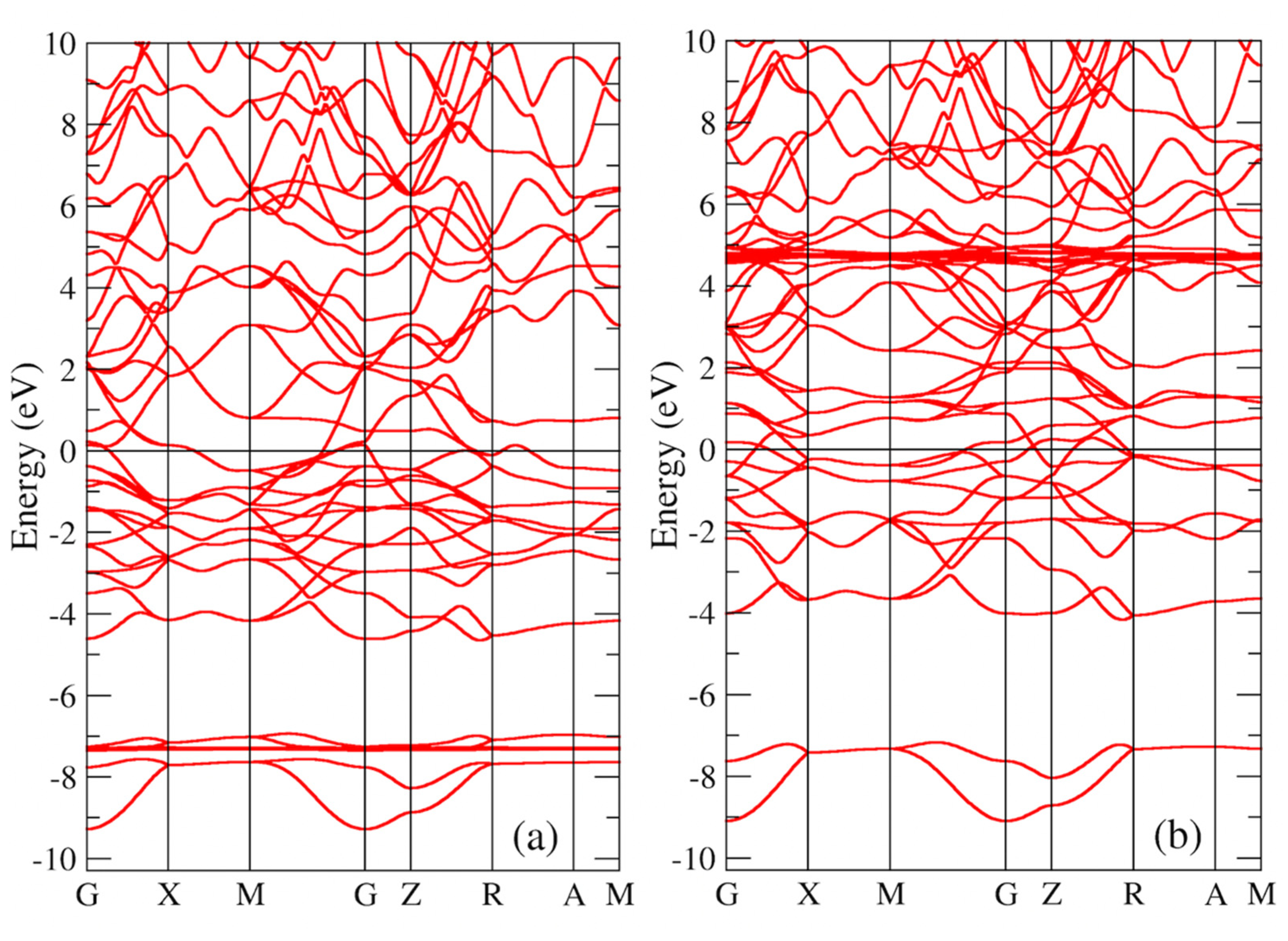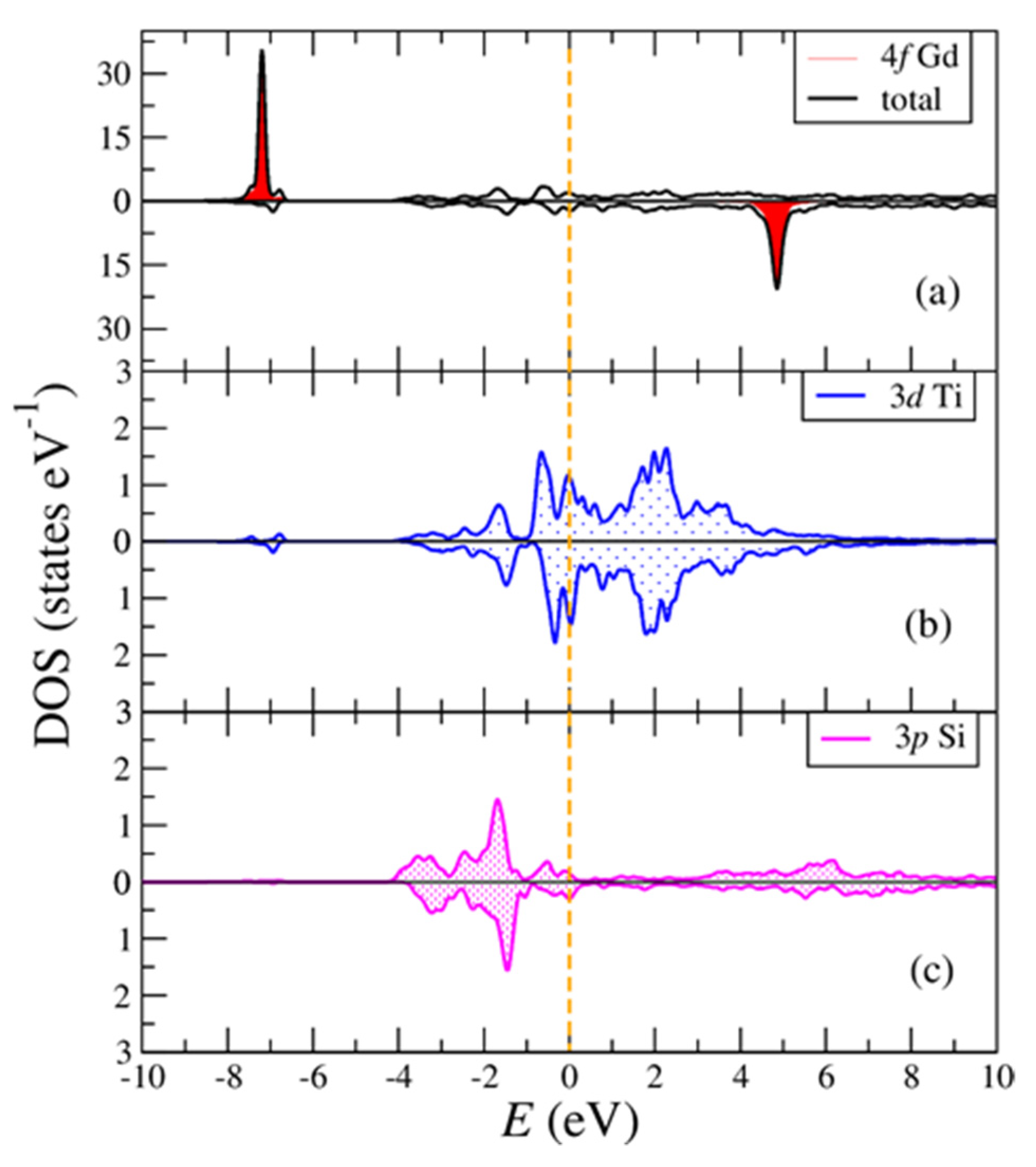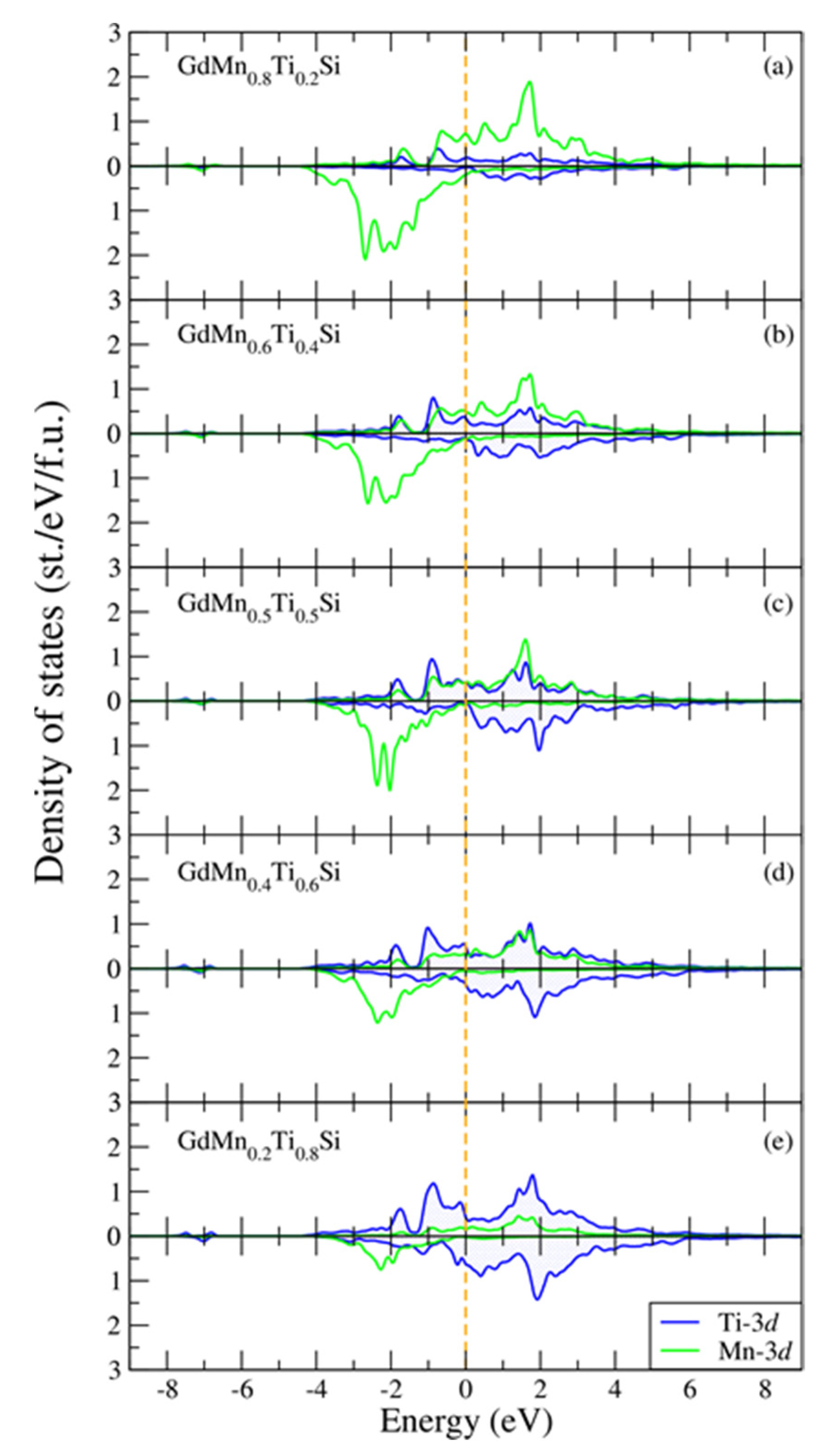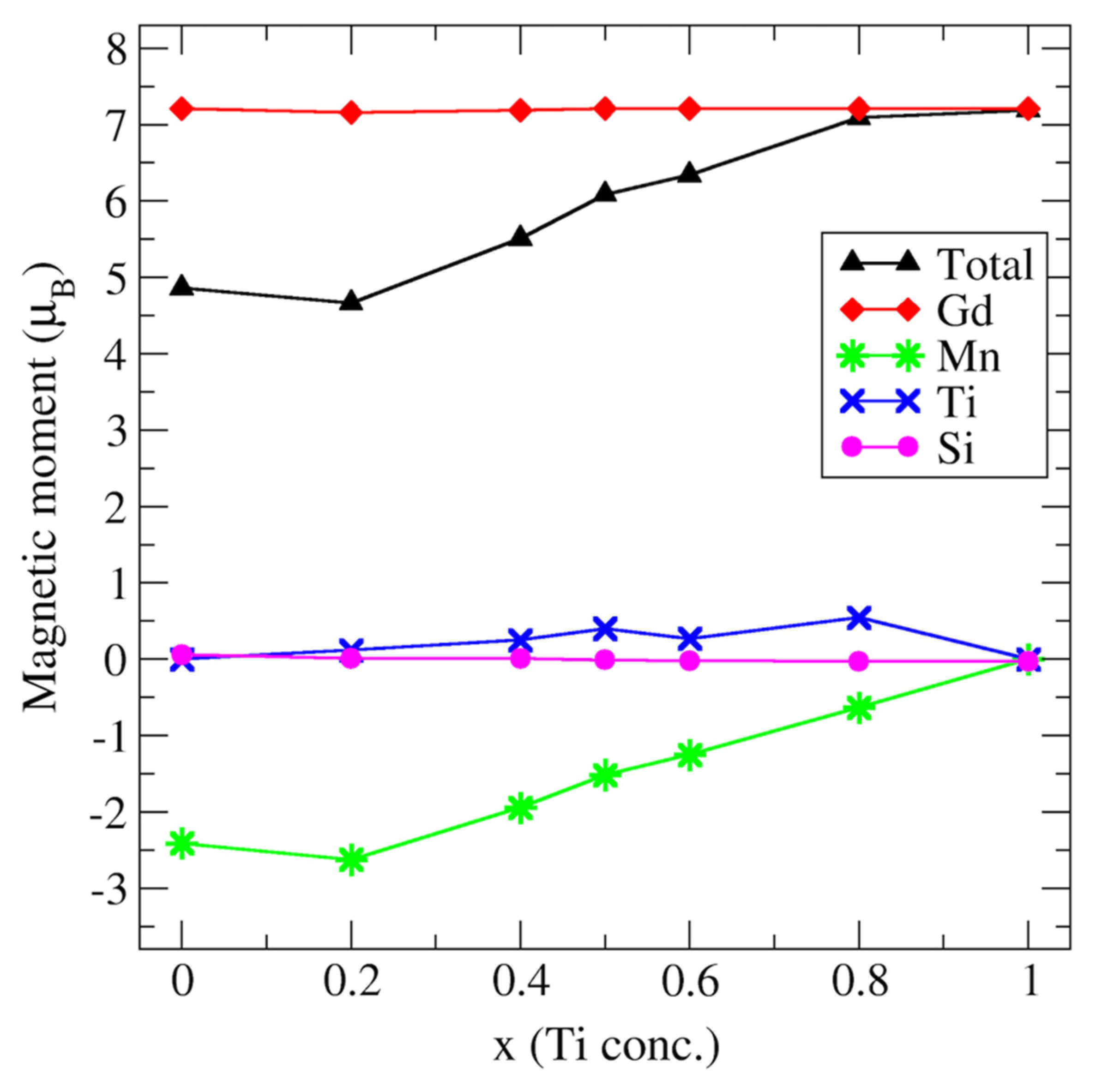Composition-Induced Magnetic Transition in GdMn1-xTixSi Intermetallic Compounds for x = 0–1
Abstract
:1. Introduction
2. Materials and Methods
3. Results
3.1. Magnetic Ordering and Moments
3.2. Electronic Structure
4. Conclusions
Author Contributions
Funding
Conflicts of Interest
References
- Franco, V.; Blázquez, J.S.; Ipus, J.J.; Law, J.Y.; Moreno-Ramírez, L.M.; Conde, A. Magnetocaloric effect: From materials research to refrigeration devices. Prog. Mater. Sci. 2018, 93, 112–232. [Google Scholar] [CrossRef]
- Gupta, S.; Suresh, K.G. Review on magnetic and related properties of RTX compounds. J. Alloys Comp. 2015, 618, 562–606. [Google Scholar] [CrossRef] [Green Version]
- Zhang, H.; Shen, B.-G. Magnetocaloric effects in RTX intermetallic compounds (R = Gd–Tm, T = Fe–Cu and Pd, X = Al and Si). Chin. Phys. B 2015, 24, 127504. [Google Scholar] [CrossRef]
- Gupta, S.; Suresh, K.G.; Nigam, A.K.; Lukoyanov, A.V. Magnetism in RRhGe (R = Tb, Dy, Er, Tm): An experimental and theoretical study. J. Alloys Comp. 2015, 640, 56–63. [Google Scholar] [CrossRef] [Green Version]
- Klosek, V.; Verniére, A.; Ouladdiaf, B.; Malaman, B. Crystal and magnetic structures of the R(=Y, Dy–Tm)MnGe compounds. J. Magn. Magn. Mater. 2003, 256, 69–92. [Google Scholar] [CrossRef]
- Kuchin, A.G.; Platonov, S.P.; Lukoyanov, A.V.; Volegov, A.S.; Gaviko, V.S.; Mukhachev, R.D.; Yakovleva, M.Y. Remarkable increase of Curie temperature in doped GdFeSi compound. Intermetallics 2021, 133, 107183. [Google Scholar] [CrossRef]
- Gupta, S.; Suresh, K.G.; Nigam, A.K.; Knyazev, Y.V.; Kuz’min, Y.I.; Lukoyanov, A.V. The magnetic, electronic and optical properties of HoRhGe. J. Phys. D Appl. Phys. 2014, 47, 365002. [Google Scholar] [CrossRef] [Green Version]
- Gupta, S.; Suresh, K.G.; Lukoyanov, A.V. Effect of complex magnetic structure on the magnetocaloric and magneto-transport properties in GdCuSi. J. Mater. Sci. 2015, 50, 5723–5728. [Google Scholar] [CrossRef]
- Chen, J.; Shen, B.G.; Dong, Q.Y.; Hu, F.X.; Sun, J.R. Giant reversible magnetocaloric effect in metamagnetic HoCuSi compound. Appl. Phys. Lett. 2010, 96, 152501. [Google Scholar] [CrossRef] [Green Version]
- Zhang, H.; Wu, Y.-Y.; Long, Y.; Wang, H.-S.; Zhong, K.-X.; Hu, F.-X.; Sun, J.-R.; Shen, B.-G. Large reversible magnetocaloric effect in antiferromagnetic HoNiSi compound. J. Appl. Phys. 2014, 116, 213902. [Google Scholar] [CrossRef]
- Venturini, G.; Malaman, B.; Ressouche, E. Neutron diffraction study of the TbMnGe compound. J. Alloys Comp. 1996, 243, 98–105. [Google Scholar] [CrossRef]
- Ivanova, T.I.; Nikitin, S.A.; Bogdanov, A.E.; Morozkin, A.V.; Suski, W.; Warchulska, J.K. Effect of Ga substitution for Ge on magnetic and crystal properties of the GdMnGe1-xGax intermetallics. Intermetallics 2005, 13, 857–861. [Google Scholar] [CrossRef]
- Nikitin, S.A.; Ivanova, T.I.; Ovchenkova, Y.A.; Maslennikova, M.V.; Burkhanov, G.S.; Chistyakov, O.D. The influence of interatomic distances on magnetic ordering in RMnSi compounds (R = La, Y, Sm, and Gd). Phys. Solid State 2002, 44, 308–311. [Google Scholar] [CrossRef]
- Gschneidner, K.A.; Pecharsky, V.K. The influence of magnetic field on the thermal properties of solids. Mater. Sci. Eng. A 2000, 287, 301–310. [Google Scholar] [CrossRef]
- Oboz, M.; Talik, E. Properties of the GdTX (T = Mn, Fe, Ni, Pd, X = Al, In) and GdFe6Al6 intermetallics. J. Alloys Comp. 2011, 509, 5441–5446. [Google Scholar] [CrossRef]
- Nikitin, S.A.; Ivanova, T.I.; Tskhadadze, I.A.; Skokov, K.P.; Telegina, I.V. Magnetic anisotropy and magnetic properties of RTSi (R = Gd, Y; T = Mn, Fe) compounds. J. Alloys Comp. 1998, 280, 16–19. [Google Scholar] [CrossRef]
- Ovtchenkova, I.A.; Nikitin, S.A.; Ivanova, T.I.; Tskhadadze, G.A.; Skourski, Y.V.; Suski, W.; Nizhankovskii, V.I. Magnetic ordering and magnetic transitions in GdMnSi compound. J. Alloys Comp. 2008, 451, 450–453. [Google Scholar] [CrossRef]
- Skorek, G.; Deniszczyk, J.; Szade, J.; Tyszka, B. Electronic structure and magnetism of ferromagnetic GdTiSi and GdTiGe. J. Phys. Condens. Matter. 2001, 13, 6397. [Google Scholar] [CrossRef]
- Morozkin, A.V. Quarternary Gd3Ti2MnSi3 compound in the GdMn1−xTixSi (x = 0…1) section of Gd-Mn-Ti-Si system at 1073 K. J. Alloys Compd. 1999, 292, 162–165. [Google Scholar] [CrossRef]
- Nikitin, S.A.; Tskhadadze, I.A.; Morozkin, A.V.; Seropegin, Y.D. The influence of Ti on the itinerant magnetism of RTX compounds. J. Magn. Magn. Mater. 1999, 196–197, 632–633. [Google Scholar] [CrossRef]
- Momma, K.; Izumi, F. VESTA 3 for three-demensional visualization of crystal, volumetric and morphologt data. J. Appl. Crystallogr. 2011, 44, 1272–1276. [Google Scholar] [CrossRef]
- Zhan, Y.; Ma, J.; Sun, Z.; Hua, Z.; Du, Y. The isothermal section of the Gd–Ti–Si ternary system at 773 K. J. Alloys Compd. 2009, 475, 268–272. [Google Scholar] [CrossRef]
- Anisimov, V.I.; Aryasetiawan, F.; Lichtenstein, A.I. First-principles calculations of the electronic structure and spectra of strongly correlated systems: The LDA+U method. J. Phys. Condens. Matter 1997, 9, 767–808. [Google Scholar] [CrossRef] [Green Version]
- Giannozzi, P.; Andreussi, O.; Brumme, T.; Bunau, O.; Buongiorno Nardelli, M.; Calandra, M.; Car, R.; Cavazzoni, C.; Ceresoli, D.; Cococcioni, M.; et al. Advanced capabilities for materials modelling with Quantum ESPRESSO. J. Phys. Condens. Matter 2017, 29, 465901. [Google Scholar] [CrossRef] [Green Version]
- Perdew, J.P.; Burke, J.P.; Ernzerhof, M. Generalized Gradient Approximation Made Simple. Phys. Rev. Lett. 1996, 77, 3865–3868. [Google Scholar] [CrossRef] [Green Version]
- Baglasov, E.D.; Lukoyanov, A.V. Electronic structure of intermetallic antiferromagnet GdNiGe. Symmetry 2019, 11, 737. [Google Scholar] [CrossRef] [Green Version]
- Liechtenstein, A.I.; Anisimov, V.I.; Zaanen, J. Density-functional theory and strong interactions: Orbital ordering in Mott-Hubbard insulators. Phys. Rev. B 1994, 52, R5467. [Google Scholar] [CrossRef] [PubMed] [Green Version]
- Topsakal, M.; Wentzcovitch, R.M. Accurate projected augmented wave (PAW) datasets for rare-earth elements (RE = La–Lu). Comput. Mater. Sci. 2014, 95, 263–270. [Google Scholar] [CrossRef] [Green Version]
- Vedmedenko, E.Y.; Kawakami, R.K.; Sheka, D.D.; Gambardella, P.; Kirilyuk, A.; Hirohata, A.; Binek, C.; Chubykalo-Fesenko, O.; Sanvito, S.; Kirby, B.J.; et al. The 2020 magnetism roadmap. J. Phys. D Appl. Phys. 2020, 53, 453001. [Google Scholar] [CrossRef]








| Compound | Total Magnetic Moment, μB | Gd Magnetic Moment, μB | Mn Magnetic Moment, μB | Ti Magnetic Moment, μB | Si Magnetic Moment, μB |
|---|---|---|---|---|---|
| GdMnSi | 4.86 | 7.21 | −2.41 | - | 0.06 |
| GdMn0.8Ti0.2Si | 4.66 | 7.16 | −3.28 | 0.59 | 0.01 |
| GdMn0.6Ti0.4Si | 5.51 | 7.19 | −3.24 | 0.63 | 0.01 |
| GdMn0.5Ti0.5Si | 6.09 | 7.21 | −3.03 | 0.80 | −0.01 |
| GdMn0.4Ti0.6Si | 6.34 | 7.21 | −3.13 | 0.67 | −0.02 |
| GdMn0.2Ti0.8Si | 7.09 | 7.21 | −3.17 | 0.68 | −0.03 |
| GdTiSi | 7.19 | 7.21 | - | 0.01 | −0.03 |
| Compound | DOS Value for Majority (Up) Spin, States/(eV f.u.) | DOS Value for Minority (Down) Spin, States/(eV f.u.) | Total DOS Value, States/(eV f.u.) |
|---|---|---|---|
| GdMnSi | 1.73 | 0.47 | 2.20 |
| GdMn0.8Ti0.2Si | 1.45 | 0.91 | 2.36 |
| GdMn0.6Ti0.4Si | 1.43 | 0.59 | 2.03 |
| GdMn0.5Ti0.5Si | 1.36 | 0.35 | 1.71 |
| GdMn0.4Ti0.6Si | 1.22 | 1.01 | 2.22 |
| GdMn0.2Ti0.8Si | 1.11 | 1.38 | 2.48 |
| GdTiSi | 1.86 | 2.20 | 4.06 |
Publisher’s Note: MDPI stays neutral with regard to jurisdictional claims in published maps and institutional affiliations. |
© 2021 by the authors. Licensee MDPI, Basel, Switzerland. This article is an open access article distributed under the terms and conditions of the Creative Commons Attribution (CC BY) license (https://creativecommons.org/licenses/by/4.0/).
Share and Cite
Mukhachev, R.D.; Lukoyanov, A.V. Composition-Induced Magnetic Transition in GdMn1-xTixSi Intermetallic Compounds for x = 0–1. Metals 2021, 11, 1296. https://doi.org/10.3390/met11081296
Mukhachev RD, Lukoyanov AV. Composition-Induced Magnetic Transition in GdMn1-xTixSi Intermetallic Compounds for x = 0–1. Metals. 2021; 11(8):1296. https://doi.org/10.3390/met11081296
Chicago/Turabian StyleMukhachev, Roman D., and Alexey V. Lukoyanov. 2021. "Composition-Induced Magnetic Transition in GdMn1-xTixSi Intermetallic Compounds for x = 0–1" Metals 11, no. 8: 1296. https://doi.org/10.3390/met11081296
APA StyleMukhachev, R. D., & Lukoyanov, A. V. (2021). Composition-Induced Magnetic Transition in GdMn1-xTixSi Intermetallic Compounds for x = 0–1. Metals, 11(8), 1296. https://doi.org/10.3390/met11081296







